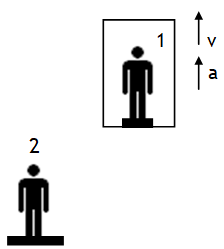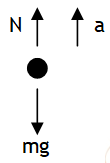^Weight in a lift
^Weight in a lift
Consider a person 1 of mass m (true weight, mg) standing on a weighing scale placed on the floor of a lift. The reading (R) of weighing scale is called his apparent weight, the scale by the person.

Let the lift is speeding up with acceleration ‘a’ w.r.t. a stationary ground observer 2 (inertial). Using NSL from the frame of reference of 2 we get:
N – mg = ma _ _ _ _ (1) 
Person 1 is in a non inertial frame, thus experiences a pseudo force (ma) opposite to acceleration of lift frame & is stationary w.r.t. lift under the influence of mg, N & ma, thus
(-mg) + (+N) + (-ma) =0 _ _ _ _ (2) 
From (1) & (2) we are getting same result
N = R = m (g + a).
1. R = m (g + a), if the lift moves
(a) upward with uniform acceleration or
(b) downward with uniform deceleration.
2. R = m (g – a), if the lift moves
(a) upward with uniform deceleration or
(b) downward with uniform acceleration.
3. R = m g, if the lift moves
(a) upwards with constant velocity or
(b) downwards with constant velocity or
(c) if the lift is at rest.
4. R = 0, if the lift falls freely under gravity i.e. (a = g).
